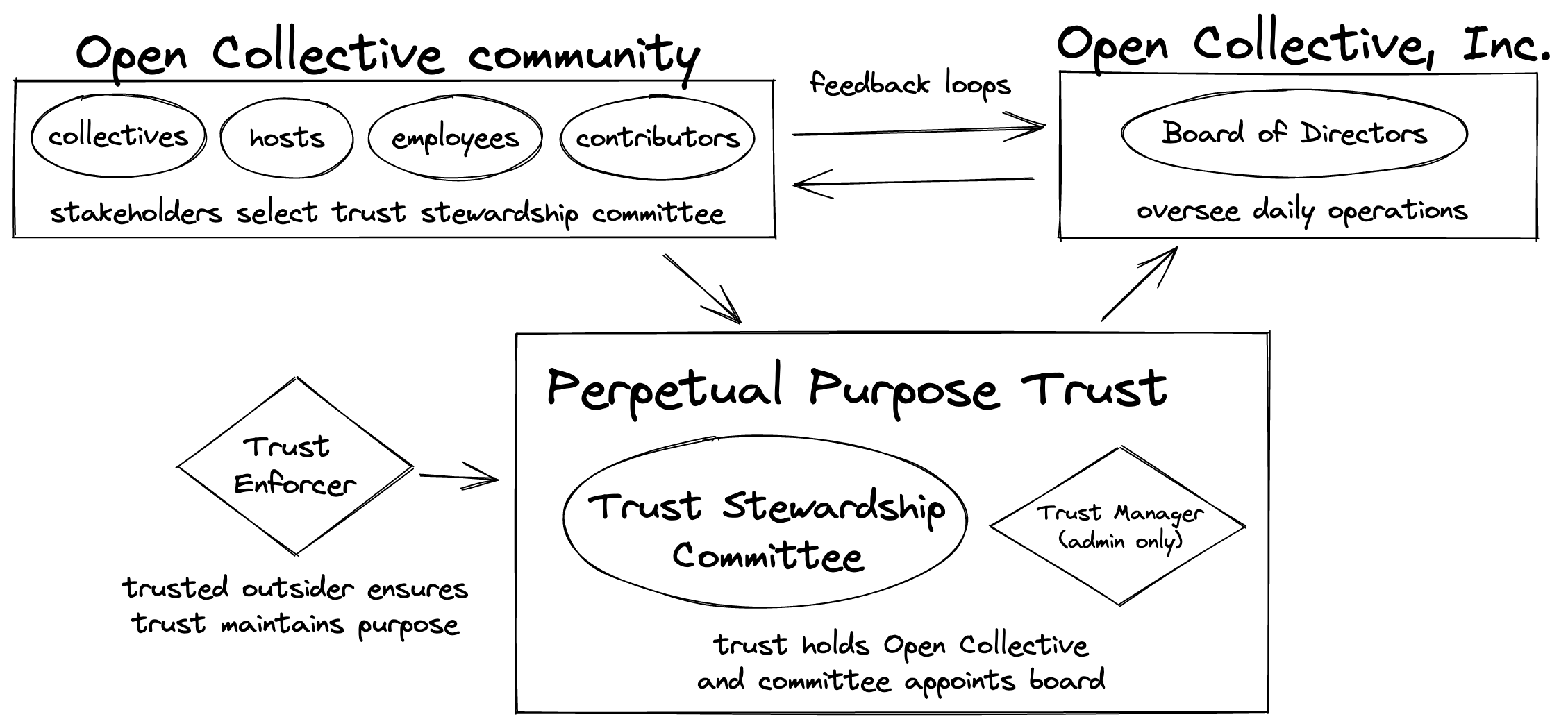Deep dive: community stewardship of Open Collective through a Perpetual Purpose Trust

Stay up to date on our journey here. Many thanks to Purpose for their invaluable resources on this subject.
In a recent post on Open Collective’s dream of an “exit to community,” we named four characteristics which our solution requires:
- Multi-stakeholder community governance
Gives power to the community while (1) maintaining our efficiency, adaptability, resilience, and sustainability, and (2) accounting for a variety of stakeholders spread across disciplines and geographies, including employees, Fiscal Hosts, Collectives, funders, investors and individual contributors. - Purpose protection
Safeguards Open Collective’s integrity and purpose, protecting against sale, co-option, and subversion. - Liquidity
Harnesses capital (i.e., money) so that our impact-driven investors, founders, and employees can eventually exit confidently and reinvest in new social enterprises. - Long term vision
Orients Open Collective toward the long-term needs of our community and the world.
One of the most interesting legal structures we know of at this point is something called a perpetual purpose trust (PPT).
What does a perpetual purpose trust seek to accomplish?
Perpetual purpose trusts (PPTs) are a form of steward ownership. Steward ownership is an alternative to conventional ownership that allows for a group of stewards to govern a company during a period of time. The structure permanently secures a company’s mission and independence in its legal DNA. In many cases, a non-commercial entity, like a foundation or trust, takes ownership of a company to retool its goals and incentives and ensure that it is independent, values-driven, and purpose-led in the long term.
Why is this necessary? Traditional for-profit corporate structures are driven by one thing and one thing only: profit. Their purpose is to maximize value for their shareholders. As we recently learned from the Purpose Foundation (full disclosure: Purpose invested $40,000 in Open Collective Inc. in 2017), standard corporate purposes reads as follows:
The purpose of the corporation is to engage in any lawful activity for which corporations may be organized under the General Corporation Law of Delaware.
Open Collective, and other companies seeking an exit to community, see the world differently. We are driven by the impact we want to make on the world. Steward ownership is a way to ensure that, even after our current founders, leaders, and team have moved on, Open Collective will still stay focused on its purpose.
While the concept of steward-ownership may be new to many, it is actually quite established, especially in Europe. Major businesses like BOSCH, Novo Nordisk, and Zeiss, along with our friends at Mozilla and OpenAI, use steward ownership to future-proof their mission.
The prevailing belief in the business world is that if you don't obsess over the bottomline, you won't see the profits others see. But what we've seen is that steward-owned companies’ long-term profit margins outperform traditional companies. They are 6x more likely to survive their first 40 years. Returns also tend to be less volatile and more resilient in the long run. Employees are happier and stay longer. What’s not to like?
There are several different legal structures that can facilitate steward ownership in the US. One option is ownership by a foundation. Open Collective would be sold to a foundation we control, which would ensure that surplus funds go back into our work, or to the community via the owning charitable foundation.
Another option, used by some new companies like Sharetribe, spreads decision-making power amongst a set of individual stewards, and utilizes a special, valueless “golden share,” which gives a non-commercial entity veto power over major decisions, like the sale of the company.
Given the wide variety of stakeholders in the Open Collective community, we feel drawn to one particular option for steward ownership in the US that provides the benefits of both foundation ownership and “golden share” stewardship: the Perpetual Purpose Trust.
How does it work?
A perpetual purpose trust (PPT) is a non-charitable nonprofit trust that, like in foundation ownership, holds (at least 51% of) the company on behalf of the community. Similar to a “golden share” arrangement, there is a trusted outside organization (a “trust enforcer”) that has the power to hold the trust to its core purpose.
This is particularly interesting because it gets rid of the dichotomy between for-profit and nonprofit. The nonprofit PPT owns a for-profit entity (like an LLC or corporation) and has the ability to distribute the dividends of that venture to the community members. This means that a venture can be run as efficiently as a traditional company, including taking on investment, while still having the added accountability to a larger community and the public. All this is possible within the PPT ownership structure.
PPTs’ core governing body is a “trust stewardship committee,” sometimes called a trust protector committee, elected by the community on a regular basis. In a typical PPT, the trust stewardship committee selects the board of directors for the company, delegating to the board of directors and then to company leadership the oversight of the company’s day-to-day operations.
It’s called a “perpetual purpose” trust because 1) unlike other trusts it exists in perpetuity and 2) the trust is created to further a particular purpose. In our case, the purpose would mirror Open Collective’s mission: to enable communities to be sustainable and fundraise in full transparency without having to create a legal entity to do so. The trust enforcer is responsible for ensuring that the trust does not deviate from that purpose and would block sale or cooptation of Open Collective. A trust management firm also maintains the administrative requirements of the trust.
The relationships described above and shown in the diagram below are defined by a “trust agreement” establishing the roles and responsibilities of all parties.
One example of a perpetual purpose trust in action is Organically Grown Company, who have been using one since 2018. Elizabeth Nardi, CEO of OGC, said:
The purpose trust ownership model embeds OGC’s commitment to sustainable agriculture and business at the center of our governance and financing structure. It enables us to bring on aligned financing to increase our impact, while also sharing real-time economic rewards with all our stakeholders who contribute value to our business. This structure is powerful because it aligns and motivates all stakeholders to row together toward our common goal.
Open Collective, too, has a variety of stakeholders and a commitment to sustainability. We are passionate about aligned financing and want to find ways that our community can benefit from our exit. Most of all, we want this process to bring our community together, and align us in our purpose.
Would a perpetual purpose trust meet our requirements?
Let's evaluate PPTs using the priority list we referenced at the top.
Multi-stakeholder community governance
Gives power to the community while (1) maintaining our efficiency, adaptability, resilience, and sustainability, and (2) accounting for a variety of stakeholders spread across disciplines and geographies, including employees, Fiscal Hosts, Collectives, funders, investors and individual contributors.
Open Collective stakeholders are able to run for seats and vote on representatives on the trust stewardship committee. We are, however, well aware of the limits of representative democracy, and the way it puts a damper on participation. Whether as a result of politics, bureaucracy, or simply the limitations of such a committee in comparison to the diversity of the Open Collective ecosystem, a traditional small committee would never be able to truly represent our global community.
Thankfully, the perpetual purpose trust model is flexible. There is space for experimentation in governance, since we can define specific, unique relationships within the trust agreement. It gives us, and the Trust Stewardship Committee, room to practice good governance of an infrastructure for the commons. How can we balance participation with efficiency and nimbleness?
Purpose protection
Safeguards Open Collective’s integrity and purpose, protecting against sale, co-option, and subversion.
Perpetual purpose trusts shine here.
Liquidity
Harnesses capital (i.e., money) so that our impact-driven investors, founders, and employees can eventually exit confidently and reinvest in new social enterprises.
Perpetual purpose trusts do not directly address liquidity or financing, although there are plenty of possibilities, such as buying back shares from investors using a combination of debt and equity. They offer flexibility, and it would be possible for the company to take on capital or distribute dividends, in the future within this structure, should it be required and properly encoded within the agreement.
Long term vision
Orients Open Collective toward the long-term needs of our community and the world.
Perpetual purpose trusts handily meet this requirement. Once the PPT owns 51% of the company, the trust can be depended on to maintain it for years to come.
Ownership vs. Stewardship
In a perpetual purpose trust, it should be noted, the community does not technically “own” Open Collective - they “steward” it. But the separation of ownership from governance allows for a great deal of experimentation within the trust agreement(s). We can dream together about how these different operating bodies intersect and interact.
As we’ve talked about our exit to community over the last few months, we’ve used different language to describe what we hope to accomplish:
- “Open Collective community” vs “the commons” vs “infrastructure”
- “Stewardship” vs “ownership”
- “Governance” (in many flavors)
- “By” vs “on behalf of”
As we explore what our exit could look like, keep in mind the minute differences between these arrangements. Is ownership by our community the same as giving Open Collective to the commons? What about Open Collective becoming infrastructure? Should ownership and governance be tied together, as in stock markets or DAOs, or separated, as in steward ownership and perpetual purpose trusts? Will the community actually own Open Collective? Or will they only govern it?
We’ve been delighted to see two different proposals come in over the last two months from folks excited about what our exit to community could look like. Both utilize blockchain technology to facilitate governance and ownership of Open Collective by the community, but in totally different ways.
We’ll be discussing these proposals in more detail in a future blog post, but the idea of a DAO - a decentralized autonomous organization, organized on the blockchain - is a useful contrast with the perpetual purpose trust we’ve described in this post.
PPTs are legal structures, whereas DAOs are native to the Internet, with related DAO legal structures still in their early stages. Whereas PPTs separate governance from ownership, DAOs often have them intertwined (sometimes in quite interesting and nuanced ways).
DAOs can more easily involve a global community, and have democracy and participation baked into their ownership and governance structure. This does, however, come with risks around exposure to malicious actors and power consolidation. DAOs are new, also, and still have a problem with widespread accessibility. PPTs, on the other hand, are less global in nature but provide conventional legal accountability and will dependably protect the purpose of Open Collective, in perpetuity.
We know that legal, financial, and technical structures are only as strong as the people who create, grow, and enforce them. Behind every abstract structure and well-intentioned governance document are daily practices that reinforce equity, or don’t. Behind every logistical “no” is a lack of desire to make the road by walking, to protect a vision and to re-interpret it, for generations.
Continuous innovation requires continuous learning. Thanks for coming along with us.

